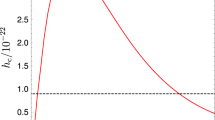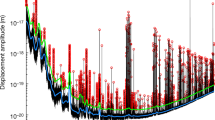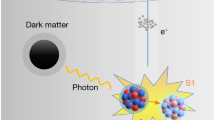Abstract
Much like ordinary matter, dark matter might consist of elementary particles, and weakly interacting massive particles are one of the prime suspects. During the past decade, the sensitivity of experiments trying to directly detect them has improved by three to four orders of magnitude, but solid evidence for their existence is yet to come. We overview the recent progress in direct dark matter detection experiments and discuss future directions.
This is a preview of subscription content, access via your institution
Access options
Access Nature and 54 other Nature Portfolio journals
Get Nature+, our best-value online-access subscription
$29.99 / 30 days
cancel any time
Subscribe to this journal
Receive 12 print issues and online access
$209.00 per year
only $17.42 per issue
Buy this article
- Purchase on Springer Link
- Instant access to full article PDF
Prices may be subject to local taxes which are calculated during checkout



Similar content being viewed by others
References
Bertone, G., Hooper, D. & Silk, J. Particle dark matter: evidence, candidates and constraints. Phys. Rep. 405, 279–390 (2005).
Savage, C., Freese, K. & Gondolo, P. Annual modulation of dark matter in the presence of streams. Phys. Rev. D 74, 043531 (2006).
Jungman, G., Kamionkowski, M. & Griest, K. Supersymmetric dark matter. Phys. Rep. 267, 195–373 (1996).
Smith, M. C. et al. The RAVE survey: constraining the local galactic escape speed. Mon. Not. R. Astron. Soc. 379, 755–772 (2007).
Peccei, R. D. & Quinn, H. R. CP conservation in the presence of instantons. Phys. Rev. Lett. 38, 1440–1443 (1977).
Wilczek, F. Problem of strong P and T invariance in the presence of instantons. Phys. Rev. Lett. 40, 279–282 (1978).
Kim, J. E. Light pseudoscalars, particle physics and cosmology. Phys. Rep. 150, 1–177 (1987).
Marsh, D. J. E. Axion cosmology. Phys. Rep. 643, 1–79 (2016).
Gaskins, J. M. A review of indirect searches for particle dark matter. Contemp. Phys. 57, 496–525 (2016).
Lewin, J. D. & Smith, P. F. Review of mathematics, numerical factors, and corrections for dark matter experiments based on elastic nuclear recoil. Astropart. Phys. 6, 87–112 (1996).
Strigari, L. E. Neutrino coherent scattering rates at direct dark matter detectors. New J. Phys. 11, 105011 (2009).
Gutlein, A. et al. Solar and atmospheric neutrinos: background sources for the direct dark matter search. Astropart. Phys. 34, 90–96 (2010).
Ruppin, F., Billard, J., Figueroa-Feliciano, E. & Strigari, L. Complementarity of dark matter detectors in light of the neutrino background. Phys. Rev. D 90, 083510 (2014).
Dedes, A., Giomataris, I., Suxho, K. & Vergados, J. D. Searching for secluded dark matter via direct detection of recoiling nuclei as well as low energy electrons. Nucl. Phys. B 826, 148–173 (2010).
Gaitskell, R. J. Direct detection of dark matter. Annu. Rev. Nucl. Part. Sci. 54, 315–359 (2004).
Bernabei, R. et al. Final model independent result of DAMA/LIBRA-phase1. Eur. Phys. J. C 73, 2648 (2013).
Aalseth, C. E. et al. (CoGeNT Collaboration) CoGeNT: a search for low-mass dark matter using p-type point contact germanium detectors. Phys. Rev. D 88, 012002 (2013).
Angloher, G. et al. Results from 730 kg days of the CRESST-II Dark Matter Search. Eur. Phys. J. C 72, 1971 (2012).
Agnese, R. et al. (CDMS Collaboration) Silicon detector dark matter results from the final exposure of CDMS II. Phys. Rev. Lett. 111, 251301 (2013).
Billard, J., Strigari, L. & Figueroa-Feliciano, E. Implication of neutrino backgrounds on the reach of next generation dark matter direct detection experiments. Phys. Rev. D 89, 023524 (2014).
Bagnaschi, E. A. et al. Supersymmetric dark matter after LHC Run 1. Eur. Phys. J. C 75, 500 (2015).
Angle, J. et al. (XENON Collaboration) First results from the XENON10 dark matter experiment at the Gran Sasso National Laboratory. Phys. Rev. Lett. 100, 021303 (2008).
Aprile, E. et al. (XENON100 Collaboration) Limits on spin-dependent WIMP-nucleon cross sections from 225 live days of XENON100 data. Phys. Rev. Lett. 111, 021301 (2013).
Akerib, D. S. et al. (LUX Collaboration) First results from the LUX dark matter experiment at the Sanford Underground Research Facility. Phys. Rev. Lett. 112, 091303 (2014).
Akerib, D. S. et al. (LUX Collaboration) Improved limits on scattering of weakly interacting massive particles from reanalysis of 2013 LUX data. Phys. Rev. Lett. 116, 161301 (2016).
Tan, A. et al. (PandaX-II Collaboration) Dark matter results from first 98.7 days of data from the PandaX-II experiment. Phys. Rev. Lett. 117, 121303 (2016).
Aprile, E. et al. Liquid xenon detectors for particle physics and astrophysics. Rev. Mod. Phys. 82, 2053–2097 (2010).
Akerib, D. S. et al. (LUX Collaboration) The Large Underground Xenon (LUX) experiment. Nucl. Instrum. Methods A 704, 111–126 (2013).
Mei, D. & Hime, A. Muon-induced background study for underground laboratories. Phys. Rev. D 73, 053004 (2006).
Akerib, D. S. et al. (LUX Collaboration) Results from a search for dark matter in the complete LUX exposure. Phys. Rev. Lett. 118, 021303 (2017).
Tan, A. et al. (PandaX Collaboration) Dark matter search results from the commissioning run of PandaX-II. Phys. Rev. D 93, 122009 (2016).
Kang, K. J. et al. Status and prospects of a deep underground laboratory in China. J. Phys. Conf. Ser. 203, 012028 (2010).
Aprile, E. et al. (XENON100 Collaboration) XENON100 dark matter results from a combination of 477 live days. Phys. Rev. D 94, 122001 (2016).
Aprile, E. et al. (XENON Collaboration) Physics reach of the XENON1T dark matter experiment. J. Cosmol. Astropart. Phys. 1604, 027 (2016).
Akerib, D. S. et al. (LZ Collaboration) LUX-ZEPLIN (LZ) conceptual design report. Preprint at http://arxiv.org/abs/1509.02910 (2015).
Aalbers, J. et al. (DARWIN Collaboration) DARWIN: towards the ultimate dark matter detector. J. Cosmol. Astropart. Phys. 1611, 017 (2016).
Minamino, A. (XMASS Collaboration) XMASS experiment, dark matter search with liquid xenon detector. Nucl. Instrum. Methods A 623, 448–450 (2010).
Abe, K. (XMASS Collaboration) XMASS experiment. AIP Conf. Proc. 1743, 050001 (2016).
Ichimura, K. (XMASS Collaboration) XMASS 1.5, the next step of the XMASS experiment. In The 34th International Cosmic Ray Conf. 1223 (Proceedings of Science, 2015).
Wright, A. (DarkSide Collaboration) The DarkSide Program at LNGS 414–420 (Astroparticle, Particle, Space Physics and Detectors for Physics Applications, 2012).
Agnes, P. et al. (DarkSide Collaboration) First results from the DarkSide-50 Dark matter experiment at Laboratori Nazionali del Gran Sasso. Phys. Lett. B 743, 456–466 (2015).
Agnes, P. et al. (DarkSide Collaboration) Results from the first use of low radioactivity argon in a dark matter search. Phys. Rev. D 93, 081101 (2016).
Davini, S. (DarkSide Collaboration) The DarkSide awakens. J. Phys. Conf. Ser. 718, 042016 (2016).
Amaudruz, P.-A. et al. (DEAP Collaboration) DEAP-3600 dark matter search. Nucl. Part. Phys. Proc. 273–275, 340–346 (2016).
Amaudruz, P.-A. et al. Measurement of the scintillation time spectra and pulse-shape discrimination of low-energy beta and nuclear recoils in liquid argon with DEAP-1. Astropart. Phys. 85, 1–23 (2016).
Fatemighomi, N. (DEAP-3600 Collaboration) DEAP-3600 dark matter experiment. Preprint at http://arxiv.org/abs/1609.07990 (2016).
Agnese, R. et al. (SuperCDMS Collaboration) Search for low-mass weakly interacting massive particles with SuperCDMS. Phys. Rev. Lett. 112, 241302 (2014).
Agnese, R. et al. (SuperCDMS Collaboration) New results from the search for low-mass weakly interacting massive particles with the CDMS low ionization threshold experiment. Phys. Rev. Lett. 116, 071301 (2016).
Kang, K.-J. et al. (CDEX Collaboration) Introduction to the CDEX experiment. Front. Phys. 8, 412–437 (2013).
Zhao, W. et al. (CDEX Collaboration) Search of low-mass WIMPs with a p-type point contact germanium detector in the CDEX-1 experiment. Phys. Rev. D 93, 092003 (2016).
Aalseth, C. E. et al. (CoGeNT Collaboration) Results from a search for light-mass dark matter with a P-type point contact germanium detector. Phys. Rev. Lett. 106, 131301 (2011).
Barreto, J. et al. (DAMIC Collaboration) Direct search for low mass dark matter particles with CCDs. Phys. Lett. B 711, 264–269 (2012).
Aguilar-Arevalo, A. et al. (DAMIC Collaboration) Search for low-mass WIMPs in a 0.6 kg day exposure of the DAMIC experiment at SNOLAB. Phys. Rev. D 94, 082006 (2016).
Bravin, M. et al. (CRESST Collaboration) The CRESST dark matter search. Astropart. Phys. 12, 107–114 (1999).
Angloher, G. et al. (CRESST Collaboration) Results on light dark matter particles with a low-threshold CRESST-II detector. Eur. Phys. J. C 76, 25 (2016).
Agnese, R. et al. (SuperCDMS Collaboration) Projected sensitivity of the SuperCDMS SNOLAB experiment. Preprint at http://arxiv.org/abs/1610.00006 (2016).
Strauss, R. et al. The CRESST-III low-mass WIMP detector. J. Phys. Conf. Ser. 718, 042048 (2016).
Alexander, J. et al. Dark sectors 2016 workshop: community report. Preprint at http://arxiv.org/abs/1608.08632 (2016)
Amole, C. et al. (PICO Collaboration) Dark matter search results from the PICO-2L C3F8 bubble chamber. Phys. Rev. Lett. 114, 231302 (2015).
Amole, C. et al. (PICO Collaboration) Dark matter search results from the PICO-60 CF3I bubble chamber. Phys. Rev. D 93, 052014 (2016).
Amole, C. et al. (PICO Collaboration) Improved dark matter search results from PICO-2L Run 2. Phys. Rev. D 93, 061101 (2016).
Akerib, D. S. et al. (LUX Collaboration) Results on the spin-dependent scattering of weakly interacting massive particles on nucleons from the Run 3 data of the LUX experiment. Phys. Rev. Lett. 116, 161302 (2016).
Fu, C. B. et al. (PandaX Collaboration) Spin-dependent WIMP-nucleon cross section limits from first data of PandaX-II experiment. Preprint at http://arxiv.org/abs/1611.06553 (2016).
Mayet, F. et al. A review of the discovery reach of directional Dark Matter detection. Phys. Rep. 627, 1–49 (2016).
Acknowledgements
This work is supported by grants from the National Science Foundation of China (Nos. 11435008, 11455001, 11505112 and 11525522), a grant from the Ministry of Science and Technology of China (Grant No. 2016YFA0400301), and in part by the Chinese Academy of Sciences Center for Excellence in Particle Physics (CCEPP), the Key Laboratory for Particle Physics, Astrophysics and Cosmology, Ministry of Education, and Shanghai Key Laboratory for Particle Physics and Cosmology (SKLPPC). Finally, we thank the Hong Kong Hongwen Foundation for financial support.
Author information
Authors and Affiliations
Corresponding author
Ethics declarations
Competing interests
The authors declare no competing financial interests.
Rights and permissions
About this article
Cite this article
Liu, J., Chen, X. & Ji, X. Current status of direct dark matter detection experiments. Nature Phys 13, 212–216 (2017). https://doi.org/10.1038/nphys4039
Received:
Accepted:
Published:
Issue Date:
DOI: https://doi.org/10.1038/nphys4039
This article is cited by
-
Extending the detectable window of dark matter direct detection experiments through boosted and Migdal effects
Science China Physics, Mechanics & Astronomy (2023)
-
Calculation of Dark Matter as a Feature of Space–Time
Foundations of Physics (2023)
-
Associated production of neutrino and dark fermion at future lepton colliders
Journal of High Energy Physics (2023)
-
Is the W-boson mass enhanced by the axion-like particle, dark photon, or chameleon dark energy?
Science China Physics, Mechanics & Astronomy (2022)
-
Revisiting the fermionic dark matter absorption on electron target
Journal of High Energy Physics (2022)




